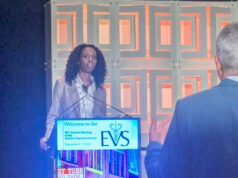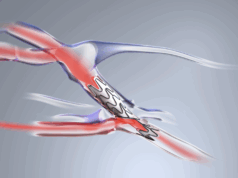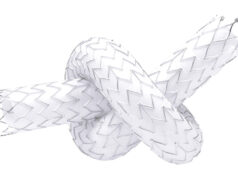
It was not just presentation sessions that featured during the Sunday morning of the American Society of Diagnostic and Interventional Nephrology (ASDIN) 19th Annual Scientific Meeting (17–19 February, Orlando, USA). Among the several hands-on elements of the conference were tutorials on the “one-minute check” for dialysis access as well as a cannulation simulator.
Deborah Brouwer-Maier (Transonic, Ithaca, USA) spoke to Renal Interventions during the session to explain the utility of and rationale behind the one-minute check. She noted that it is the physical examination recommended by the Kidney Disease Outcomes Quality Initiative (KDOQI) for checking a vascular access. She outlined that it is a “look, listen and feel” standardised test initially used and published by Gerald Beathard (University of Texas Medical Branch, Galveston, USA), who has featured it as part of the core curriculum with ASDIN.
The check includes “an arm elevation test, where the fistula is raised to see if it collapses—if it doesn’t collapse, it indicates the area of stenosis”. Also part of the check is “an augmentation test where you occlude to check the inflow”. Brouwer-Maier noted that it was a work group sponsored by the Fistula First Initiative that helped develop the method. It was designed to be performable by anyone from a clinician through to a dialysis technician nurse and even a caregiver. With that in mind, it was modelled on CPR checks that can be performed quickly and easily.
Brouwer-Maier made the case for the check: “When you talk to staff, most do not even take that minute to assess the access. Then, they cannulate the access and run into problems—if you do the one-minute check first, it reduces cannulation complications. You will know if the access is working, whether there is an aneurysm, an area at risk for a fatal access bleed, or an infection. You will feel the vessel and the thrill, listen to it and know whether there is a stenosis. It increases the chances of a successful cannulation in just one minute.”
Beyond educating at ASDIN, Brouwer-Maier said the aspiration was to take the check global. Centres without ultrasound may derive particular benefit, she suggested, though it also has a place in more fully equipped clinics. Cannulation mapping, demonstrated at the session by Forest Rawls (Emory Healthcare Dialysis Clinics, Atlanta, USA), was another way to assess the best approach to a given cannulation procedure.
Simulating cannulation
Also featured during the Sunday hands-on sessions was a novel device for identifying what constitutes skilled cannulation. Joseph Ravi Singapogu (Clemson University, Clemson, USA), who led the team that developed the cannulation simulator, was on hand to explain how it allows the angle and pressure of a cannulation procedure to be evaluated in real time.
“We have sensor-ised cannulation: rather than the subjective opinion of a dialysis technician, the expertise will be measured by sensors,” Singapogu said. “The goal is to help improve skill—and if you cannot measure, how can you track skill progress?”
“The pressure is a really big one,” Brouwer-Maier added. “When I used to do “cannulation camp”—training with a fake arm—all I could do was try to figure out how tightly a trainee was holding the needle to understand how much pressure they were applying. The simulator is a way for the trainee themselves to know when the pressure or angle is wrong while they perform the procedure.”
Brouwer-Maier and Singapogu were united in saying that they hoped the simulator would end the use of patients as practice models. “If we were physicians,” Brouwer-Maier said, “that would not be happening.”
Singapogu stated in summary: “You are only as strong as your weakest link. Is cannulation that weakest link?” The simulator, he hopes, will make it easier to answer that question in the negative.










